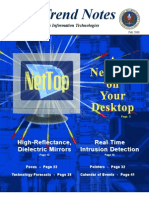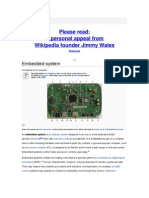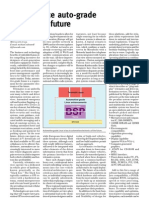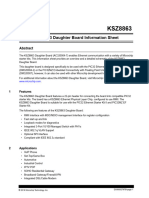Components of Embedded System
Components of Embedded System
Uploaded by
Chauhan SriyamCopyright:
Available Formats
Components of Embedded System
Components of Embedded System
Uploaded by
Chauhan SriyamOriginal Description:
Original Title
Copyright
Available Formats
Share this document
Did you find this document useful?
Is this content inappropriate?
Copyright:
Available Formats
Components of Embedded System
Components of Embedded System
Uploaded by
Chauhan SriyamCopyright:
Available Formats
[TYPE THE DOCUMENT TITLE]
EMBEDDED SYSTEM: IMPORTANT FACTS AND FIGURES
Objective:
To present important facts and new trends in the field of embedded system and hence to show its
importance and need in modern era.
INTRODUCTION:
DEFINITION:
An embedded system is one that has computer hardware
with software embedded in it as one of its components.
Or
We can define an embedded system as A microprocessor based system that does not look like a
computer.
Or
we can say that it is A combination of computer hardware and software, and perhaps additional
mechanical or other parts, designed to perform a dedicated function. In some cases, embedded systems are
part of a larger system or product, as is the case of an antilock braking system in a car .
SOFTWARE PROGRAM
#include <16f876a.h>
#use delay (clock=20000000)
#byte PORTB=6
main()
{
set_tris_b(0);
portb=255;
//decimal
delay_ms(1000);
portb=0b10101010; //binary
delay_ms(500);
}
HARDWA
RE
EMBEDDED SYSTEM
Components of Embedded System:
It has Hardware,Processor, Timers, Interrupt controller, I/O Devices, Memories, Ports, etc.
It has main Application Software Which may perform concurrently the series of tasks or multiple tasks.
It has Real Time Operating System (RTOS)
Heart of Embedded system is its microcontroller.Some moncrocontrollers are:
[TYPE THE DOCUMENT TITLE]
Application:
Due to their compact size, low cost and simple design aspects embedded systems are very popular and encroached
into human lives and have become indispensable. They are found everywhere from kitchen ware to space craft.
To emphasize this idea here are some illustrations.
Embedded systems span all aspects of modern life and there are many examples of their use.
a) Biomedical Instrumentation ECG Recorder, Blood cell recorder, patient monitor system
b) Communication systems pagers, cellular phones, cable TV terminals, fax and transreceivers, video games
and so on.
c) Peripheral controllers of a computer Keyboard controller, DRAM controller, DMA controller, Printer
controller, LAN controller, disk drive controller.
d) Industrial Instrumentation Process controller, DC motor controller, robotic systems, CNC machine controller,
close loop engine controller, industrial moisture recorder cum controller.
e) Scientific digital storage system, CRT display controller, spectrum analyser.
APPLICATION OF EMBEDDED SYSTEM
What makes embedded systems different?
Real time operation
size
cost
time
2
[TYPE THE DOCUMENT TITLE]
reliability
safety
energy
security
How Embedded Systems Interacts with the external environment !
External Environment can interact with an embedded system through sensors.
Embedded system can interact with an environment through actuator.
Characteristics of a Embedded system:
Special-purpose
Typically, is designed to execute a single program, repeatedly
It used to be single-purpose
Now, multi-functioned, but single-purpose
Tactic and Strategy
Tightly constrained
Low cost
Simple systems
Fewer components based
Performs functions fast enough
Minimum power
Reactive and real-time
Reactive: Continually reacts to external events
Real-time: Must compute certain results in real-time
Hardware and software co-exist
The software written for embedded systems is often called firmware
Is stored in read-only memory or Flash memory chips rather than a disk drive
MARKET:
Market of Embedded system is increasing every year-
MARKET TREND
Trends in Embedded system:
The following section provides an overview of the emerging technological trends and implications in the
development of embedded systems.
Multi-core Processors
3
[TYPE THE DOCUMENT TITLE]
8-bit controllers were widespread for quite a long time and are still powering a multitude of embedded
applications, for instance, in home appliances, smartcards and automotive body electronics. To cater to the need for
higher performance, these controllers advanced towards16-bit to 32-bit, as used in routers, cell phones and media
players.New applications in the areas of imaging, rendering, compression, multimedia and recognition demand
higher bandwidth, enhanced processing capabilities, quicker response times and more efficient algorithms. There is
a definite requirement of processors with multiple cores that would improve the throughput of the application
while reducing power consumption, cost of operation and increasing reliability. Thus, semiconductor companies
have introduced a single chip comprising multiple cores. Many of the gaming consoles and network processors use
multicore processors.
These are still early days for the widespread deployment of multi-core processors in embedded computing.
Adoption of these processors will depend how fast the entire ecosystem responds to the standardization of
technology in terms of debuggers, RTOS, compilers, integrated development environment (IDE) vendors and
programming methodologies. Companies like QNX, Montavista, Wind River Systems, National Instruments and
Mentor Graphics have taken the lead in defining tools and processes that can be applied to multi-core systems.
Wireless
For a long time, embedded devices were mostly operating as stand-alone systems. However, with the advent of
wireless connectivity, the scenario has changed. Both, short-range wireless protocols like Bluetooth, Zigbee, RFID,
near field communications (NFC) and long-range protocols such as, wireless local area network (WLAN),
WiMAX, long term evolution (LTE) and cellular communications are bound to witness more widespread
applications in the near future. The recent trends in wireless for use in embedded systems are in the areas of
system-on-chip (SoC) architecture, reduced power consumption and application of short range protocols.
Increased use of open source technology
Embedded systems have traditionally employed proprietary hardware, software, communication protocols and
home grown operating systems for their development. The payment of royalty to vendors for using a particular
4
[TYPE THE DOCUMENT TITLE]
operating system has been a significant overhead faced by the manufacturers of embedded systems. This scenario
is changing. Embedded Linux is a real time operating system that comes with royalty-free licenses, advanced
networking capabilities and a large base of engineers familiar with the Linux system. According to a recent report
by the VDC Corporation, Embedded Linux (both the free and the licensed versions) remains an attractive
choice for a range of development teams and its use is poised to see a manifold increase. Even WindRiver, the
global leader in device software optimization, joined the Linux bandwagon in 2005. It now supports both VxWorks
and Linux distributions. Software giant Microsoft, which has a Windows-based system for cellular phones, has a
separate consortium working on an open source Linux-based solution.An increasing number of manufacturers are
providing their source code free of cost to engineers or other manufacturers. Google has made its Android software
for cellular phonesavailable for free to handset makers and carriers who can then adapt it to suit their own
devices. Nokia has concrete plans to make the Symbian OS open source once it completes its acquisition of
Symbian.
Security
In an increasingly interconnected world, security in embedded devices has become critical. The security
requirements for the huge base of connected embedded devices are distinct on account of their limited memory,
constrained middleware, and low computing power. Embedded security is the new differentiator for embedded
devices. Progression in the areas of embedded encryption, cryptography, trusted computing and authentication are
covered in the following sub-sections.
Minimum bit-security level
Protection lifetime of data
80
2010
112
20112035
128
2036 and beyond
Forecast of the future security level (Source: NIST SP 800-57)
Device Convergence
Broadly speaking, any new device being introduced in the cellular, consumer electronics or infotainment segment
is a potential candidate for device convergence. So, a mobile phone not only enables one to receive calls but also
serves as a camera, PDA, navigation device, music player, texting device and can connect with other devices a
smart phone after all. An automotive infotainment system contains a navigation device, video player, parking
enablement, voice controlled applications, internet access devices, lane departure system, GPS connectivity and
Bluetooth enabled headphones. While convergence enables multiple features to be integrated into a single device,
there is another opposite trend that is somewhat divergent. What this means is that while specialized devices (for
instance digital camera, music player) exist as they are, they are enabled such that they can connect to each other.
Thus, there is a growing adoption of standards and guidelines for seamlessly connecting devices to one another.
5
[TYPE THE DOCUMENT TITLE]
Internationalization
The devices that are currently manufactured offer rich multimedia support in terms of videos and graphics and
hence, demand more processing power, higher resolution and greater bandwidth. Touch screens are on their way to
becoming the standard in a variety of devices including PDAs, infotainment systems, ticketing solutions, gaming
consoles, mobile phones, music players and hand-held devices.
With a richer human machine interface (HMI), devices also require greater levels of internationalization and
Multilanguage support as manufacturers have access to global markets. Localization and personalization of devices
falls within the ambit of baseline features. Providing multi-language support on embedded devices is accompanied
by many challenges; the major ones are the limited memory to store the font related information (bitmap font,
outline font, glyph, character, tone etc.), CPU processing power, size of the script engine and the small resolution
of the display screen. The low resolution usually degrades the readability of the display text. It is important to plan
and design the internationalization requirements of an embedded device well in advance.
Smart Devices
Machine to machine (M2M) communication, through both wired and wireless mechanisms is on the rise. While the
technology for remote connectivity has been in use for a long time, what is changing now is the business scenario
and newer use cases that remote connectivity can be and is being applied to. This is mostly being triggered by the
widespread adoption and proliferation of mobile-based communications.Wouldnt it be great if a cell phone could
inform the nearest authorized service center that it needs repair, or if the water filter at home could inform the
service center that the candle of the filter needs to be replaced or better still, if an empty food plate could beckon
the nearest waiter (waiting on the handheld!) to get itself replenished! These examples illustrate how technology
can be used to enhance the value provided by an embedded device. Additionally, these devices can offer valuable
inputs to OEMs or service providers by providing data on the usage of the device features by a consumer (of
course, subject to user consent). This will eventually help the OEMs innovate advanced features or upgrades in the
subsequent versions. It will also open up new after-market revenue streams so specific features can be targeted to
users depending on their device usage patterns and preferences.
FUTURE SCOPE:
The market of embedded system is quite big.
1.In modern days electronics accessories are demanding more and more specially automated electronic devices.
2.Growth in networking market increases the uses of wireless devices.
3. According to an ISA-Ernst & Young report of 2011, this industry was about $6.5 billion in 2009 and is expected
to log a compound annual growth rate of 17.3 per cent to reach $10.6 billion in 2012.
4. The report also suggests that the industry promises 3.5 million jobs by 2015.
5. It is expected that the market for embedded systems will grow to nearly 4 billion units by 2015, requiring nearly
14.5 billion microprocessor cores, and worth more than USD 2 trillion.
6. Embedded software segment now offers more high-value activities relating to middleware, driver design and
associated applications. The main reason for increased adoption of embedded software is its use by electronics
companies for increased device functionality, reduced time-to-market and reduction in costs.
ROLES AVAILABLE:
Embedded engineers write the software that controls the VLSI chips. Embedded software can be any code
which interacts with the hardware layer, ranging from the hardware abstraction layer, device drivers, kernel
programming to application programming.
To take up embedded software development as career, you need to have a working knowledge of C, C++
and Java, with some exposure to application software development. If you have already done some
programming for an embedded system, you can expand your horizons by broadening your skill sets.
Embedded software is being developed using a variety of embedded and real-time operating systems, such
6
[TYPE THE DOCUMENT TITLE]
as embedded NT, Windows CE and RTLinux. In addition, a variety of development tools and IDEs for C,
C++ and Java are available. You need to learn application development in these various environments.
To be a successful programmer, you need a good understanding of design alternativeshow to choose a
processor, an operating system, a programming language so that you can develop cost-effective, reliable
embedded software with minimal development time. As many of the systems become network enabled, a
working knowledge of network programming is also important. Also, you need to be aware of the diversity
of application areas and the specific requirements of each.
As a hardware/board designer, you could work on reference board design, new board design, and board
design derivatives and modifications on existing boards. Reference boards are used to validate the
capabilities of designed silicon chips.
The embedded hardware designer is responsible for hardware design schematic , PCB layout, BOM
creation, hardware board debugging and testing, and system integration testing. Desired skills are hardware
design using 8-/16-/32-bit microcontrollers, microprocessor-based systems, design of medium-frequency
boards, hardware design of analogue , mixed signal and digital, and understanding/ implementation of the
EMI and EMC concepts to hardware design.
CONCLUSION:
The trends detailed in this report have already begun impacting the concept, design, development and marketing of
embedded products. With a new product being announced almost every other day, technological changes are
sweeping the embedded world.
Wired or wireless communication between embedded devices or a back-end server is increasing and is resulting in
newer functional areas and business models. It is not surprising that out of the three billion embedded devices
forecast to be shipped this year, two-thirds are going to be connected. Plug and play kind of connectivity is the
need of the day.
Deployment of multi-core architectures, internationalization, efficient security algorithms and usage of open source
platforms is poised to grow; hence, product managers, architects, engineering teams need to understand the
implications of this growth.
Another area that could probably have an implication in the future is social networking. Certain embedded devices
could eventually turn out to be suitable platforms for collaboration with Web 2.0 concepts like social networking
and syndication being adopted. Eventually, a PDA device need not necessarily have a web client interface for
accessing social networking forums or subscribing to various feeds; it could on its own be a potential platform for
such collaboration. The underlying embedded technology would support syndication protocols like RSS/ATOM
that would automatically update changes.
It is also likely that embedded systems will embrace the cloud computing paradigms, as is happening in the
nonembedded world. So, it might be possible for instance, to have the RTOS, storage areas or other special
software in the cloud and have the embedded applications access them through internet connectivity.
Changes in the embedded world are occurring even as this report is being given. It is always going to be smaller,
faster, and superior in the embedded world!
You might also like
- DXT3TM Product Description TetraDocument91 pagesDXT3TM Product Description TetraSe ZeNo ratings yet
- RRN3901 User Guide (v100r011c10)Document96 pagesRRN3901 User Guide (v100r011c10)leonardomarinNo ratings yet
- Women Security SystemDocument75 pagesWomen Security Systemboddam sathvikaNo ratings yet
- Electronic Code Locking Using GSMDocument63 pagesElectronic Code Locking Using GSMSumanth MatamNo ratings yet
- Embedded System Page FileDocument17 pagesEmbedded System Page Filesaikripa121No ratings yet
- Zig VivkDocument80 pagesZig Vivksivakumar247No ratings yet
- Puting 11 MythsDocument7 pagesPuting 11 Mythsmac9papNo ratings yet
- Embedded System Development Trends: December 2006Document11 pagesEmbedded System Development Trends: December 2006Narendra WaykosNo ratings yet
- An Embedded System Is A Computer System Designed To Perform One or A Few Dedicated FunctionsDocument13 pagesAn Embedded System Is A Computer System Designed To Perform One or A Few Dedicated FunctionsIrshad AnsariNo ratings yet
- Original PDFDocument15 pagesOriginal PDFShweta HabibkarNo ratings yet
- DTMF Door LockingDocument43 pagesDTMF Door LockingBasheer T MNo ratings yet
- Current Trends in Computer Hardware & Software PlatfromsDocument11 pagesCurrent Trends in Computer Hardware & Software PlatfromsDI PathanNo ratings yet
- Internet of Things (I T) Design Considerations For Embedded Connected DevicesDocument6 pagesInternet of Things (I T) Design Considerations For Embedded Connected DevicesAnil KumarNo ratings yet
- Automatic Dim Bright Control MicrocontrollerDocument55 pagesAutomatic Dim Bright Control MicrocontrollerperumalNo ratings yet
- Embedded SystemDocument6 pagesEmbedded SystemSoundarya SvsNo ratings yet
- Fire and Gas Detection SystemDocument55 pagesFire and Gas Detection Systemsree haritha pNo ratings yet
- NomadikDocument14 pagesNomadikcodesnishNo ratings yet
- Emb and Iot FinalDocument88 pagesEmb and Iot FinalNeha KumariNo ratings yet
- Charan ReportDocument38 pagesCharan ReportCharan CNo ratings yet
- Shopping Malls Security and Power Management System Using Ir1 - 2Document57 pagesShopping Malls Security and Power Management System Using Ir1 - 2Srivani Pulakala100% (6)
- Faculty Class Alert Using GSMDocument80 pagesFaculty Class Alert Using GSMpraveen_kodgirwarNo ratings yet
- Review Questions: ISYS104 Tutorial - Week 6Document10 pagesReview Questions: ISYS104 Tutorial - Week 6Linh NguyễnNo ratings yet
- Tech Trend Notes: High-Reflect Ance, Dielectric Mirrors Real T Ime Intrusion DetectionDocument9 pagesTech Trend Notes: High-Reflect Ance, Dielectric Mirrors Real T Ime Intrusion Detectionrocky2219No ratings yet
- Identifying of Objects Using RF Transmitter and Receiver and Data Retrieving Using GSMDocument111 pagesIdentifying of Objects Using RF Transmitter and Receiver and Data Retrieving Using GSMaymangafferNo ratings yet
- Introduction To EsDocument15 pagesIntroduction To EsSHASHIKANTNo ratings yet
- 2.1 Embedded SystemsDocument44 pages2.1 Embedded SystemsAakash SheelvantNo ratings yet
- Embeddedsystems 140418034737 Phpapp02Document11 pagesEmbeddedsystems 140418034737 Phpapp02Meruva LokeshwarNo ratings yet
- U-5 HalfDocument218 pagesU-5 HalfK.P.Revathi Asst prof - IT DeptNo ratings yet
- Au AsstDocument31 pagesAu AsstGeleta SafoyiNo ratings yet
- Prasad SeminarDocument16 pagesPrasad Seminarsiddharthbadiger328No ratings yet
- Embedded System DefinitionDocument6 pagesEmbedded System DefinitionEng-ibrahim al-absiNo ratings yet
- Please Read: A Personal Appeal From Wikipedia Founder Jimmy WalesDocument19 pagesPlease Read: A Personal Appeal From Wikipedia Founder Jimmy WalesEr Sandeep KumarNo ratings yet
- Application of RFID Technology and The Maximum Spanning Tree Algorithum For Solving Vehicle Emission in Cities On IOTDocument71 pagesApplication of RFID Technology and The Maximum Spanning Tree Algorithum For Solving Vehicle Emission in Cities On IOTsrivalli pNo ratings yet
- Rfid ThesisDocument38 pagesRfid Thesisanusha prathipatiNo ratings yet
- Design of Embedded Video Monitoring System Based On ARM9Document24 pagesDesign of Embedded Video Monitoring System Based On ARM9Ch RambabuNo ratings yet
- Smart Irrigation SystemDocument42 pagesSmart Irrigation SystemNithya GundaNo ratings yet
- Submitted To: HCL Info Systems LTDDocument21 pagesSubmitted To: HCL Info Systems LTDAvinashSinghNo ratings yet
- Midterm Exam Review Questions 1 - NewDocument21 pagesMidterm Exam Review Questions 1 - NewSirus DanhNo ratings yet
- Chapter-1 Introduction To Embedded Systems: CharacteristicsDocument37 pagesChapter-1 Introduction To Embedded Systems: CharacteristicsNelarapuMaheshNo ratings yet
- Finger Print Based ATMDocument53 pagesFinger Print Based ATMVakiti Shailaja100% (1)
- Chapter 2 (B)Document13 pagesChapter 2 (B)SABITA RajbanshiNo ratings yet
- Wp493 Iiot Edge PlatformsDocument10 pagesWp493 Iiot Edge PlatformshiperboreoatlantecNo ratings yet
- BYOD WhitepaperDocument2 pagesBYOD WhitepaperSatyapriya PanigrahiNo ratings yet
- Embedded System1Document106 pagesEmbedded System1Nitesh Chouhan100% (1)
- Manual de Simatic Automation Tool SATDocument20 pagesManual de Simatic Automation Tool SATjulypezgalloniNo ratings yet
- Eeol 2005nov16 RFD Ems AnDocument3 pagesEeol 2005nov16 RFD Ems Anphineasferb00No ratings yet
- What Is An Embedded SystemDocument48 pagesWhat Is An Embedded SystemSuresh V ReddyNo ratings yet
- Research Notes of MSPDocument27 pagesResearch Notes of MSPshailendra shindeNo ratings yet
- Embedded SystemDocument11 pagesEmbedded Systemstallone21No ratings yet
- Iot Gas MonitoringDocument59 pagesIot Gas MonitoringSimeonNischithNo ratings yet
- Mobile or Telephone Landline Based Industrial Load ControlDocument97 pagesMobile or Telephone Landline Based Industrial Load Control9949843609No ratings yet
- Embedded SystemsDocument21 pagesEmbedded SystemsSumit ThakurNo ratings yet
- Embedded System: From Wikipedia, The Free EncyclopediaDocument12 pagesEmbedded System: From Wikipedia, The Free EncyclopediaAndrei Ursac100% (1)
- HW SW CodesignDocument514 pagesHW SW Codesignsindhudas91No ratings yet
- MBSE Driven IoT For Smarter Cities, Matthew Hause, 2018Document7 pagesMBSE Driven IoT For Smarter Cities, Matthew Hause, 2018garidosebastNo ratings yet
- Embedded System: 1 HistoryDocument11 pagesEmbedded System: 1 HistoryAnonymous E4Rbo2sNo ratings yet
- 67.remote Home Security System Based On WSN and GSM TechnologyDocument80 pages67.remote Home Security System Based On WSN and GSM TechnologyMounika ChowdaryNo ratings yet
- Wireless Keyboard & Mouse EmulatorDocument84 pagesWireless Keyboard & Mouse EmulatorVijitha KalassNo ratings yet
- Literature Survey 3.formation of The Problem 4.system Specification 5.design of Solution 6.implementation 7.results and DiscussionsDocument36 pagesLiterature Survey 3.formation of The Problem 4.system Specification 5.design of Solution 6.implementation 7.results and Discussionssaikripa121No ratings yet
- What Is The IoT TechnologyDocument14 pagesWhat Is The IoT Technologyangopi76No ratings yet
- Building the Internet of Things with IPv6 and MIPv6: The Evolving World of M2M CommunicationsFrom EverandBuilding the Internet of Things with IPv6 and MIPv6: The Evolving World of M2M CommunicationsNo ratings yet
- Digital Technologies – an Overview of Concepts, Tools and Techniques Associated with itFrom EverandDigital Technologies – an Overview of Concepts, Tools and Techniques Associated with itNo ratings yet
- 9310-Vxxx0 en SerialDocument174 pages9310-Vxxx0 en SerialBlair StaceyNo ratings yet
- Activity 6 Think Before You ClickDocument3 pagesActivity 6 Think Before You ClickLiamar Grace Orange Defiño100% (1)
- Cable ID Test Limit Length Headroom Date / Time: 12/02/2020 05:35:00 PM Untitled1Document8 pagesCable ID Test Limit Length Headroom Date / Time: 12/02/2020 05:35:00 PM Untitled1Yogavasth ManiNo ratings yet
- AC-425x-B Series Hardware Installation and User Manual 200818 PDFDocument42 pagesAC-425x-B Series Hardware Installation and User Manual 200818 PDFDaniel RiveraNo ratings yet
- CCIE VOICE Workbook Version 3 (Full)Document39 pagesCCIE VOICE Workbook Version 3 (Full)Aasif BaigNo ratings yet
- Prepared By: Ms. Priti RumaoDocument29 pagesPrepared By: Ms. Priti RumaoPriti Rumao100% (1)
- Zabbix 1Document83 pagesZabbix 1shortie2100No ratings yet
- Assignment 1 ITICT302A - Secure ProgrammingDocument13 pagesAssignment 1 ITICT302A - Secure ProgrammingSubrat DashNo ratings yet
- IoT - Module 1Document13 pagesIoT - Module 1bhargaviNo ratings yet
- Chapter 2 Communication and Networking - Full Lesson Notes-YEAR 12 COMPUTER SCIENCE PAPER 1Document32 pagesChapter 2 Communication and Networking - Full Lesson Notes-YEAR 12 COMPUTER SCIENCE PAPER 1Nour MuneerNo ratings yet
- Implement Split Tunneling With MikrotikDocument38 pagesImplement Split Tunneling With MikrotikAhmad SofianNo ratings yet
- KSZ8863 Daughter Board Information Sheet DS5000276 1596938Document11 pagesKSZ8863 Daughter Board Information Sheet DS5000276 1596938JarniDeGarzaNo ratings yet
- 11-8 Serial Communication: Difference Between andDocument8 pages11-8 Serial Communication: Difference Between andsubramanyam62No ratings yet
- Auto Hematology Analyzer: Minimum Size, Maximum CapabilityDocument2 pagesAuto Hematology Analyzer: Minimum Size, Maximum CapabilityAmine Arabi0% (1)
- Manual FieldServer Gamewell FCI E3 SeriesDocument20 pagesManual FieldServer Gamewell FCI E3 Seriesjof853No ratings yet
- B360 Aorus Gaming 3 Wifi B360 Aorus Gaming 3: User's ManualDocument44 pagesB360 Aorus Gaming 3 Wifi B360 Aorus Gaming 3: User's ManualNueva Imagen La Consentida de AmericaNo ratings yet
- Chapter Four Communication ParadigmsDocument48 pagesChapter Four Communication Paradigmskim98No ratings yet
- Eaton PXG MibDocument9 pagesEaton PXG MibALEXANDER PAJUELO JARA PAJUELO JARANo ratings yet
- Key To Bachillerato 2 Unit 1Document27 pagesKey To Bachillerato 2 Unit 1arianne lowell woodgateNo ratings yet
- KWP 2 KProtocolDocument13 pagesKWP 2 KProtocolmacorcheroNo ratings yet
- Cracking The Lens: Targeting HTTP's Hidden Attack Surface: OutlineDocument17 pagesCracking The Lens: Targeting HTTP's Hidden Attack Surface: OutlineoooNo ratings yet
- (Deadmau - RAWS) Green Green 2003 S01 RUS JAP DVDRip-AVC 720p DeaDocument4 pages(Deadmau - RAWS) Green Green 2003 S01 RUS JAP DVDRip-AVC 720p Deaari sudrajatNo ratings yet
- Tutorial in AnimotoDocument72 pagesTutorial in AnimotoraphaeljaybernardoNo ratings yet
- Huawei NetEngine AR600 Series Enterprise Routers DatasheetDocument13 pagesHuawei NetEngine AR600 Series Enterprise Routers DatasheetpepitolavoeNo ratings yet
- Imam Abu Hanifa BanglaDocument39 pagesImam Abu Hanifa BanglaMuhammad Hasan50% (2)
- CuteFTP v9 User GuideDocument272 pagesCuteFTP v9 User GuideIhliani APNo ratings yet
- Wonderware WSP 3.1 & Serveur OPC SOFREL - Juin 2009 - EngDocument7 pagesWonderware WSP 3.1 & Serveur OPC SOFREL - Juin 2009 - EngDaniel Leonardo Palomino CamaNo ratings yet
- A Highly Scalable IEEE802.11p Subsystem Using Communication and Localization For Increased Vehicular SafetyDocument6 pagesA Highly Scalable IEEE802.11p Subsystem Using Communication and Localization For Increased Vehicular SafetygobinathNo ratings yet

























































































